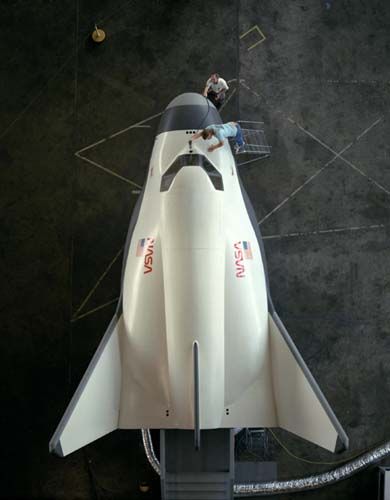A Historic Crash and its Legacy
The real “Six Million Dollar Man”
/https://tf-cmsv2-smithsonianmag-media.s3.amazonaws.com/filer/de/c6/dec691e2-cebd-4194-885d-26eec2fdad7c/e-16731-rte.jpg)
It was about the hardest landing you can have and survive. Forty-four years ago today, NASA test pilot Bruce Peterson unwittingly created the intro for 1970s television show “The Six Million Dollar Man” when he hit the lakebed in an M2-F2 lifting body aircraft at Edwards Air Force Base doing 250 miles an hour without his gear fully extended. The craft bounced, skidded and tumbled in a cloud of dust, and miraculously held together. The crash would be more sickening to watch only if he had been carrying fuel—luckily it was the aircraft’s last unpowered glide before a planned move to powered flights. Peterson was seriously injured, but recovered over the course of the next year and flew again. He died of natural causes in 2006 at age 72. The M2-F2, rebuilt as the M2-F3 with an additional vertical stabilizer, lives on at the Smithsonian.
Here are some more clips of the M2-F2.
The lifting body research at NASA was dangerous stuff, but it yielded critical data that was later used in the design of the space shuttle and the Air Force’s newest toy, the X-37 unmanned spaceplane.
But no one back then would have guessed that a commercial company early in the 21st century would use one of NASA’s precarious lifting bodies to create a private space plane. SpaceDev, the space systems unit of Sierra Nevada Corporation, is doing just that. Sierra Nevada is one of four companies that just a few weeks ago got tens of millions of dollars each from NASA in a second round of funding via the space agency’s Commercial Crew Development program (CCDev). The companies will use this money to move ahead with plans for a viable, commercial alternative to put humans and cargo into low Earth orbit after the shuttle retires this summer.

SpaceDev’s vehicle is the Dream Chaser, a derivative of the HL-20, a lifting body brother of the M2-F2. Here’s a little more information on it.
The Dream Chaser will launch atop an Atlas V rocket and carry as many as seven people to and from orbit. It will be able to dock with the International Space Station and other orbiting vessels, and return in a powerless glide to to any number of runways as the space shuttle did, only more of them, such as Denver International Airport. The company, which announced the spacecraft in 2005, hopes to begin flight tests in 2013 and move on to operational flights as early as 2014.
Thanks to Bruce Peterson, they’ll probably get the landing gear down on time, every time.